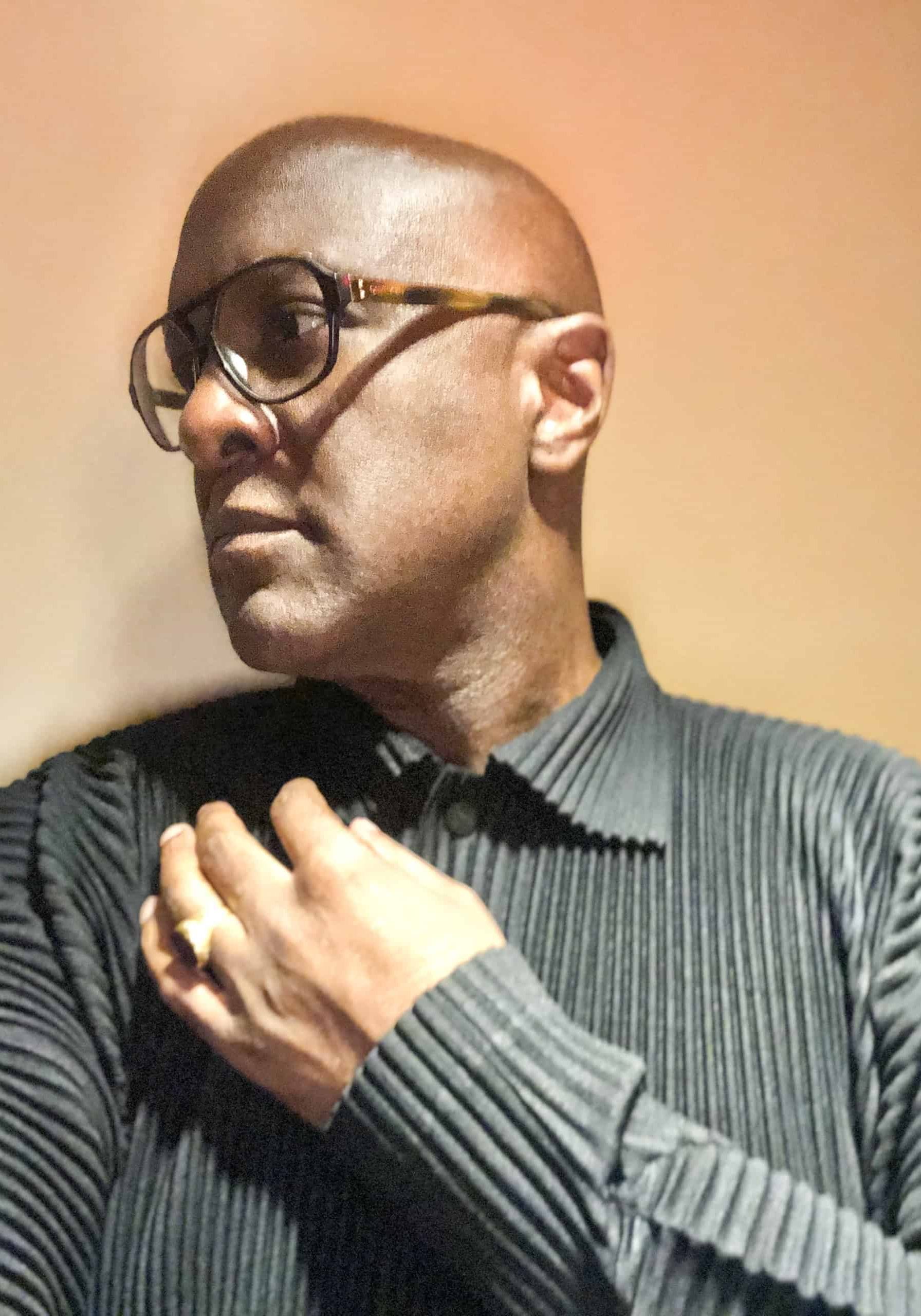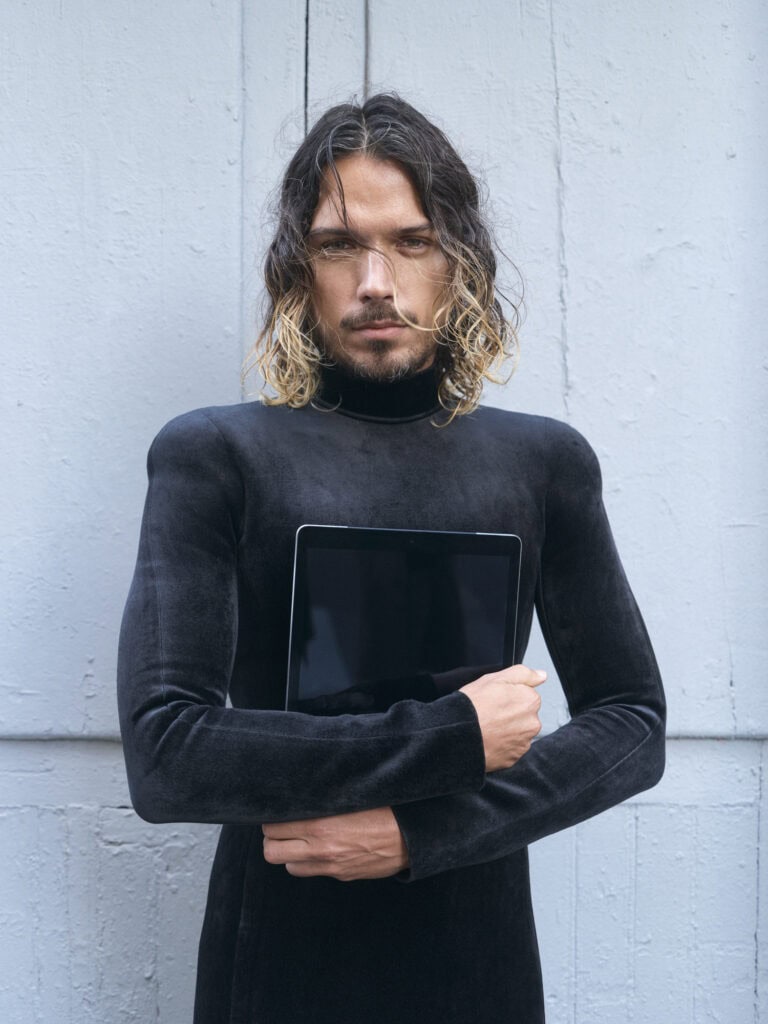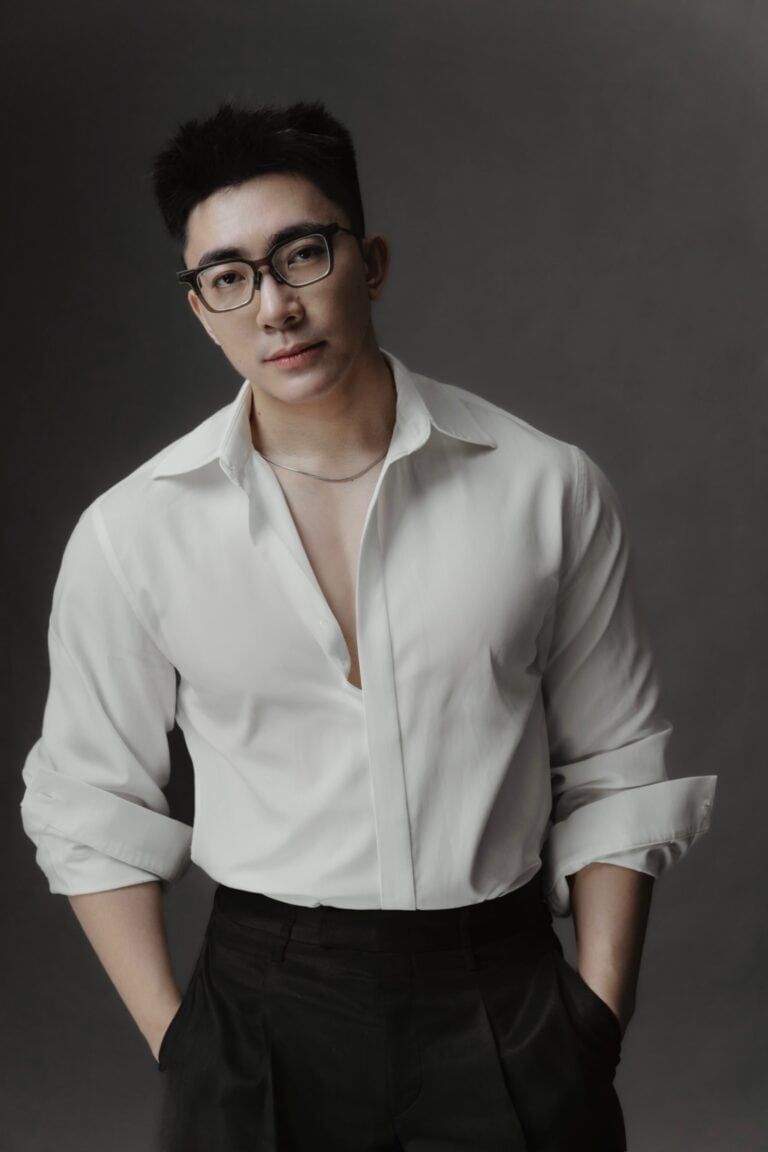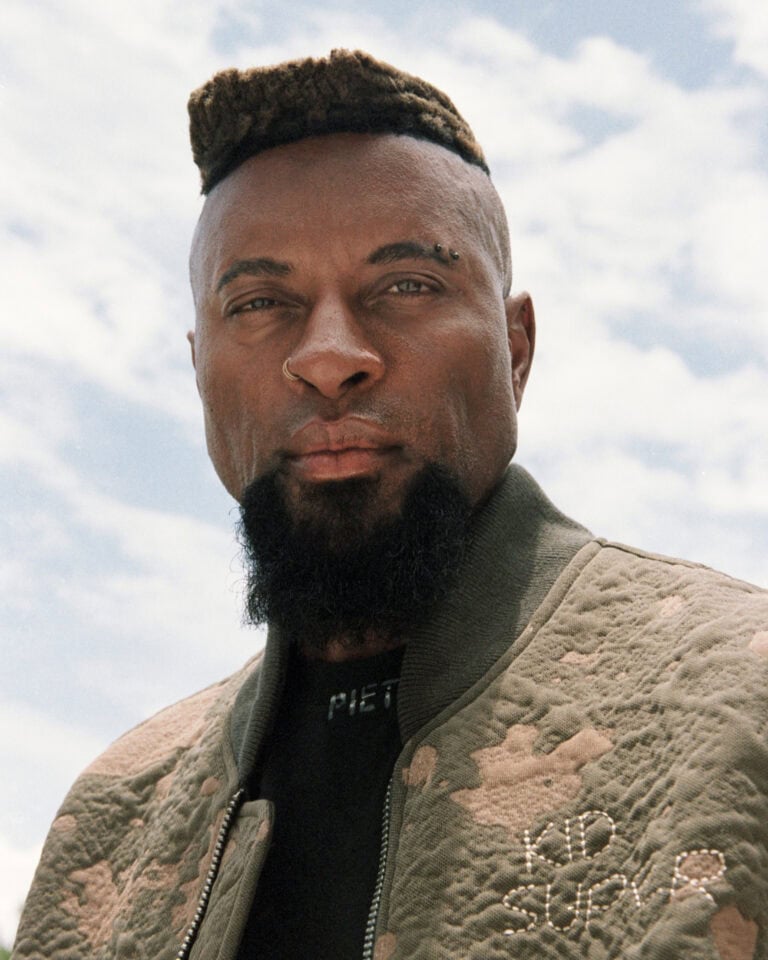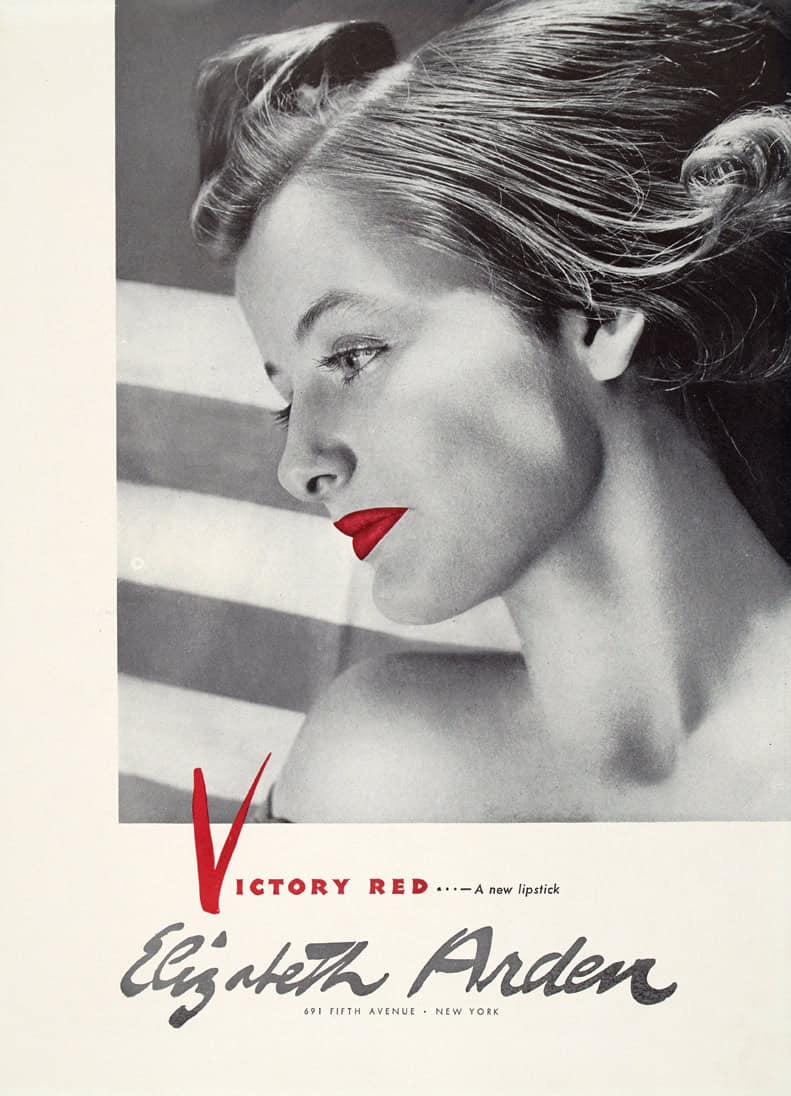
Red Lipstick a Civic Duty
Patrick Michael Hughes
Red lipstick had a civic duty during World War II. It was charged with defining a uniform look, being defiant in the face of an adversary.
Mask wearing, social distancing, lock downs and re-setting awareness leading to transformed private and public engagement are all factors, for all. Consequently citizens who are experiencing the current cultural tectonics shift and fatigue of flux. As a result awareness and conversations around civic duty was where the world found itself in 2021. Red lipstick had a civic duty during World War II.
A poignant question to ponder is what is civic duty? Civic duty has always been linked to cause, unification, changing roles and conversations for a better world for all. The acts of civic duty can be large and demonstrative. Simple to unrecognized and perhaps dismissed as not palpable enough to serve any value to a cause.
Civic Duty of Red Lipstick during World War II
Red lipstick had a civic duty during World War II. It was charged with defining a uniform look, being defiant in the face of an adversary. Red lipstick was formal and boosted morale of women and soldiers overseas. Women were on the front line of emergency services, Intelligence agencies and a range of municipal uniformed duties. During this era fashion reflected responsibility, a keen, prideful and imperative call. The fashion quickly shifted gears answering the collective pride of the war effort. It promoted new ways of showing what was relevant to the pressing global moment.
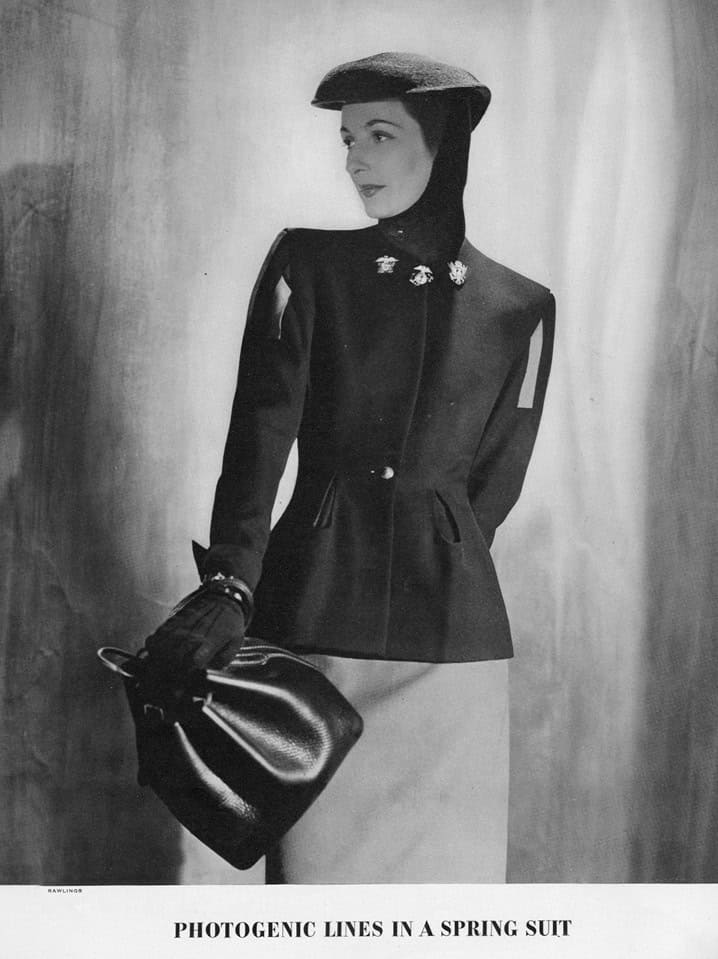
Hollywood costume designer, Gilbert Adrian popularized padded shoulder suits and blouses for a wider audience of movie fans during the late nineteen thirties. He was the architect of top box office actresses such as Joan Crawford volume styles. The creator of the approachable American sportswear associated with Katherine Hepburn’s on and off screen New England flair. After decades in Hollywood Adrian presented his first Ready to Wear collection in 1942. By the nineteen forties, fashion shifted from goddess bias cut gowns and whimsical motifs inspired from Paris couture. To well-designed, suited empowered female forms infused with sensibilities of resistance and resilience.
Detail of red lipstick
The World War II era announced the serious times required serious clothing. One defining detail related to the female uniform was the detail of red lipstick. Red lips were drawn on to be lush, visible and well defined. The fashion’s ‘outspoken mouth’ was actually an understated civic act of defiance. The ideal shape of made-up lips was no longer a ‘heart shaped rosebud’. By the nineteen forties the fashionable face was strong, engaged and unapologetic. The beauty of the period may have looked peaceful, inspiring and delightful but it was not harmless.
War work mastered by women encouraged questions, such as what is the roll of women during a time of global crisis? A larger female centered civic dialogue looking at condition, participation and freedom. Would be part of the new Europe by the end of the nineteen forties. Many of these inquiries and discussions would be brought more into light in the groundbreaking the 1949 publication of Simone de Beauvoir ‘s The Second Sex in Paris.
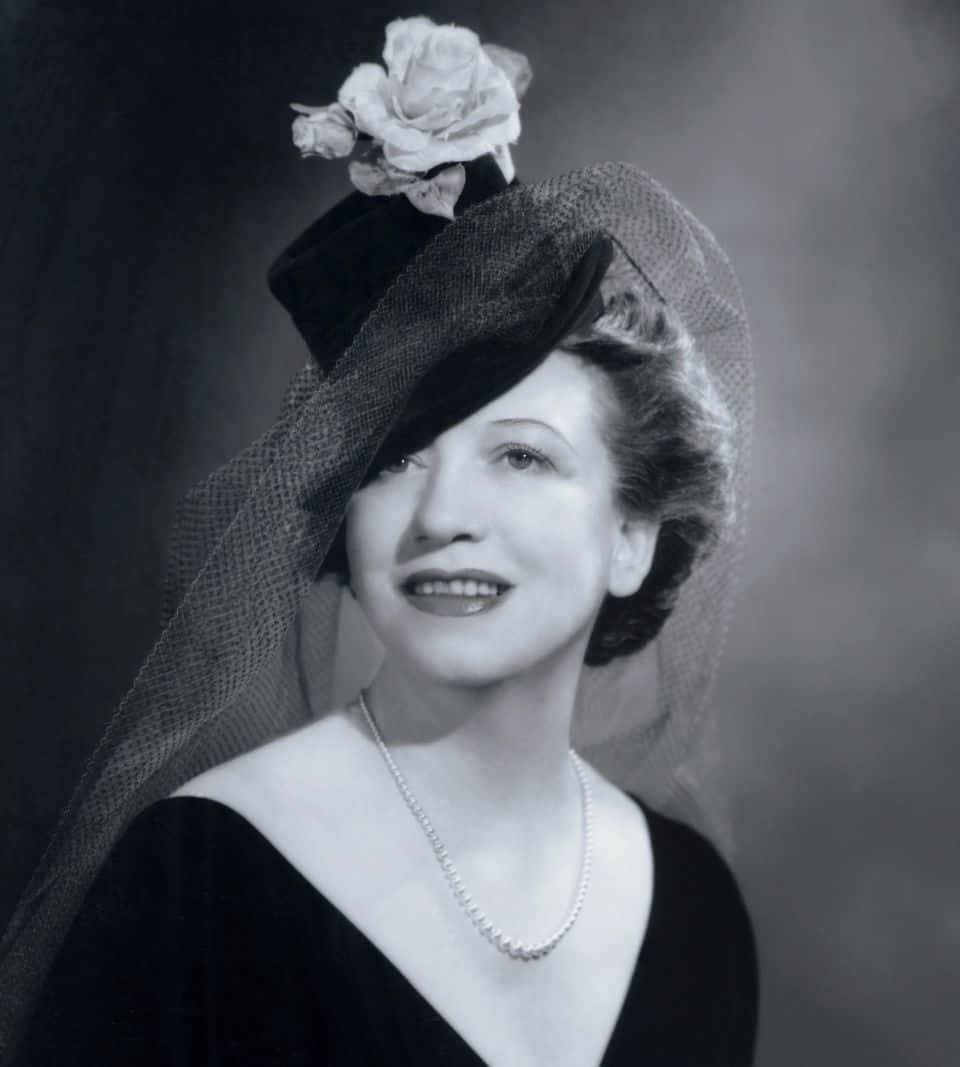
Empire of beauty
Elizabeth Arden was the beauty leader in the luxury sector. She built her business on the personal model of “achieving an objective”. Her empire of beauty products blossomed from her eight-hour beauty cream (1930) to a wide range of products including lipstick. Arden’s launch of her ‘War Face’ campaign happens through a series of right time and place in terms of the urgency of a patriotic period. Female aspiration and contemporary art shifts with in the fashionable image.
Philippe Halsman
Philippe Halsman was a highly successful contributing portrait photographer for Paris Vogue. His documentary news like style was in alignment with the emerging directions fashion photography would take during the World War II era and the Post War years. His work was part of the growing documentary style of fashion photography. Seen in leading photographers such as Richard Avedon at Harper’s Bazaar and Gordon Parks at Vogue and Life Magazine, during the forties.
There are three stylistic factors which make the Halsman image striking. The first is that the advertisement focuses on visual narrative and cultural moment not the materials of product packaging.
The second its a profile image, an unconventional choice to sell lipstick. The profile portrait format has it connections to the celebrated triumphs of Ancient Rome. The Italian Renaissance and the victories of the French and British Empires. Ford’s profile is clearly set against a backdrop of the American flag inspiring and asserting messages of duty and connection to greater political moment.
The third factor is that Halsman’s image is a stark contrast from the dominant dark glamour portrait style originated by Hollywood photographer George Hurrell. A similar genre was employed by Harper’s Bazaar fashion editor creative director Adolph de Meyer. De Meyer created the early Arden photographic images for her line of facial creams. The fashion of the distant alabaster goddess was suddenly out of step with the shift in global concerns and civic engagement.
Victory Red Lipstick
Halsman’s black and white photograph was published with a singular flourish of red lipstick on the mouth. The new shade was called ‘Victory Red‘. The advertisement was a full-page feature in The Saturday Evening Post, an enormously popular household magazine. According to beauty expert Gabriela Hernandez, author of Classic Beauty: The History of Makeup . “Hitler hated red lipstick and would not allow any women around him to wear it since he claimed it contained animal fat from sewage” . Red lipstick was defiant it was in opposition to the beauty standards of German women. When Adolph Hitler became Chancellor of Germany in 1933 the Nazi Party was a strong opponent of female emancipation.
Haus Frau
Under fascist rule German women were encouraged to be obedient wives. Charged with the task of having children and looking after the home. “Haus Frau” is the German phrase for this endearingly, efficient and domesticated woman. She was the exaltation of the traditional German values dressed in a ‘dirndl’. A silhouette which clearly communicated domesticity. It consisted of a peasant blouse, a modest calf length skirt and apron. The folkloric and functional dress is still worn the rural towns in the southern Black Forest and Alp regions of Germany.
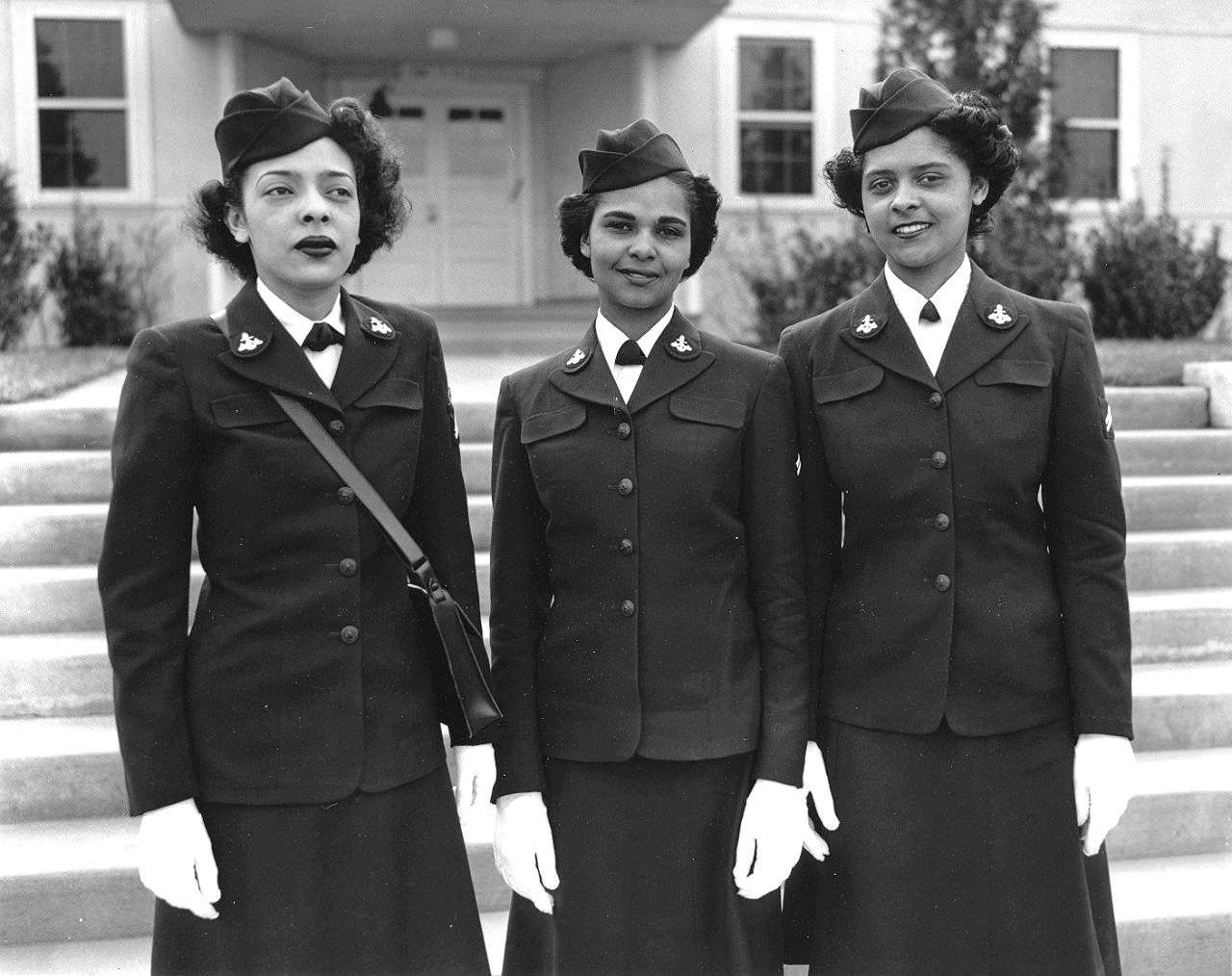
Josephine Ogden
In contrast American and allied forces espoused female service in an opposite light. Josephine Ogden Forrestal was the civilian uniform adviser to the United States Navy in 1942. The former editor for American Vogue and jewelry designer with Harry Winston for Cartier was the fashion authority who asked American-born Paris designer Mainbocher. The first American to officially show Haute Couture in Paris to design uniforms for the WAVES (Women Accepted for Volunteer Emergency Service). Their tailored, single button suit, with a knee grazing gored skirt in navy blue wool for fall-winter. With white cotton for spring-summer was accessorized with an officer’s inspired cap and wrist length white gloves. Variations on the uniform also included women’s slacks. Qualified WAVES who served had to have a four-year college degree or two year associates accompanied by a professional work resume.
WAVES
The WAVES served in over 900 shore stations in the continental United States. The women who served in the WAVES were mostly white women in addition there were seventy-two African American women. This was one of the earliest steps toward a desegregated US Navy before the end of WWII. Alas; few remained with the units after the war. The United States Navy also recognizes that seven WAVE officers and sixty-two enlisted women died during the war.
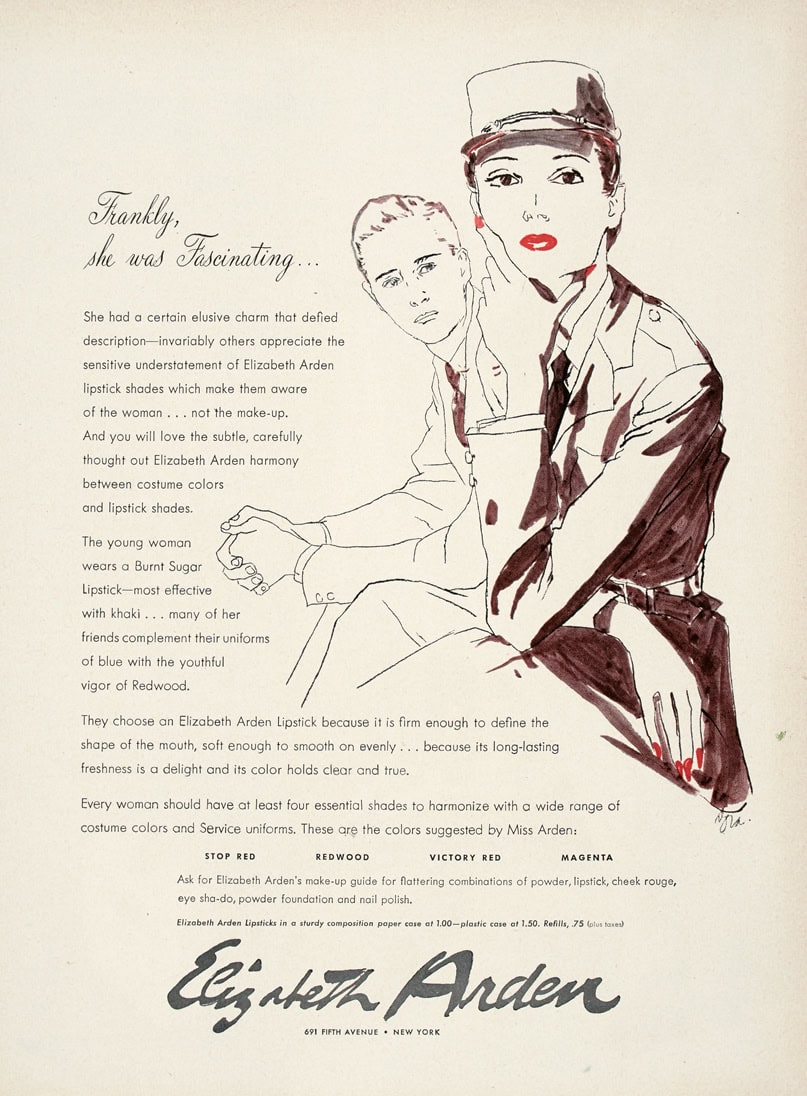
Men dominated the commercial art genre of fashion illustration. Artists such Christian Bérard who had connections to the Ballet Russe, as well as haute couture houses such as Chanel and Schiaparelli. In addition to commercial work at L’Officiel and Femina magazines. The pages of American Vogue, under the art direction of Alexander Liberman were flooded with the work Carl Erickson. Professionally known as ‘Eric’, he captured the stylish imagination of a post World War I generation to the end of the 1950’s. However, many illustrators were anonymous or their identities have been lost to time and lack of archival documentation. This was coupled with the fact that fashion illustration walked the fine line between a commercial art, brand agenda and fine art. Much of the early work was simply dismissed. Due to rise of the fashion photograph contributing to reduced work in the profession.
Dora Mathieu
“Frankly He was Fascinated” was illustrated by Dora Mathieu a noted fashion portrait artist in the 1943. She is one of the small clusters of women illustrators during the WWII period. In a number of collections and fashion illustration anthologies her signature ‘Dora’ is listed as unknown. In the 1943 Mathieu commission for Arden states “The model is wearing ‘Burnt Sugar’ lipstick most effective khaki’.
The copy praises the range of Elizabeth Arden’s harmony between dress women’s military uniforms and lipstick shades. By 1943 in addition to ‘Victory Red,’ Arden offered Stop Red, Redwood and Magenta. The palate also suggests a wide range of skin tones for all women. Sarah Schaffer, author of Reading Our Lips: The History of Lipstick Regulation in Western Seats of Power. States lipstick became a “symbol of resilient femininity in the face of danger”. Here the Arden brand celebrates red lipstick as “its long lasting freshness is a delight and its color holds clear and true”
At the end of World War II, Dora Mathieu continued to create commissioned illustrations and notable portraits of designers. She also had a career in education as a professor at her Alma mater Pratt Institute and Parsons School of Design.
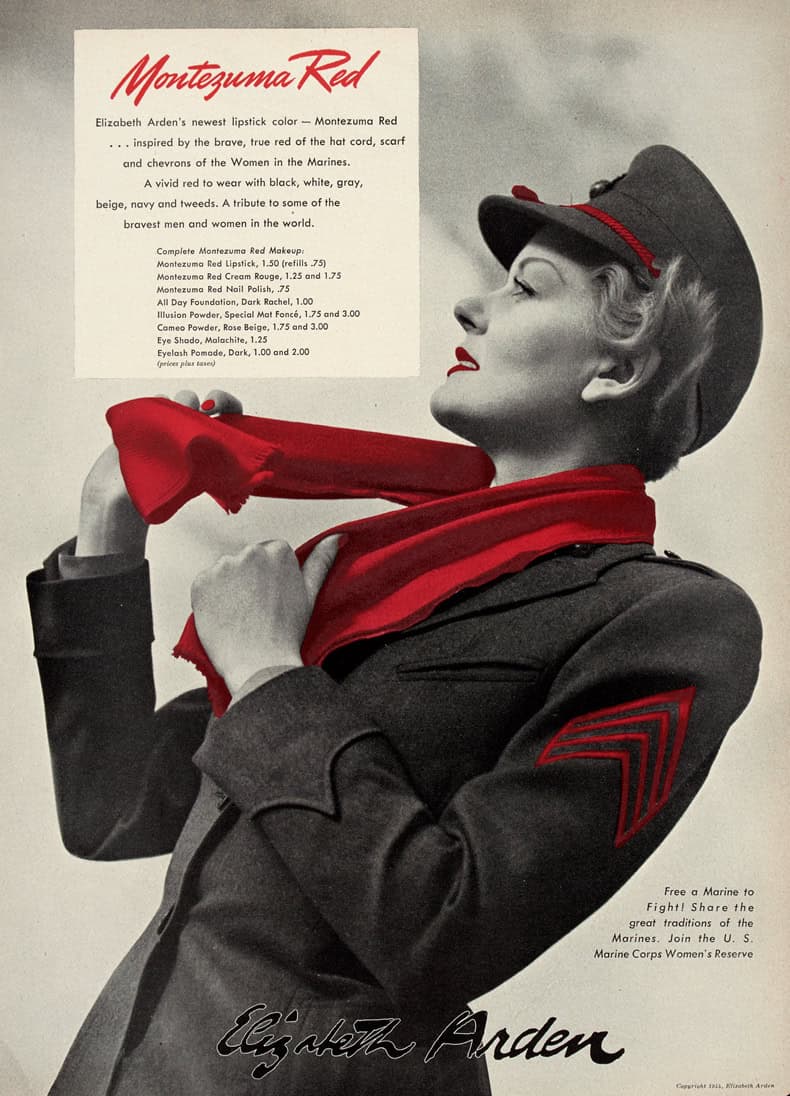
Montezuma Red Lipstick
“Montezuma Red” 1944 was a lipstick shade closely aligned with The United States Marine Corps. Together with the Marine hymn celebrating the first time the American flag was raised in what was the old world Tripoli. The format of the image resembles the simplicity of the 1941 Halsman image. The message was again a call to service and civic duty. “Inspired by the brave, true red of the hat cord, scarf and chevrons of the Women of the Marines…” . In this case red lipstick and military duty were were visibly linked to uniform and rank. Women in the Marines were recruited to free a male for essential combat duty. They were trained at historically women’s collages such as Mount Holyoke and Smith College in Massachusetts and Hunter College in New York City.
Capt. Anne A. Lentz
Capt. Anne A. Lentz was the first commissioned officer in the Marine Corps Women’s Reserve. In civilian life she was a clothing designer and an employee of the War Department. Mrs. Lentz chose to pursue a career in the Marines as a Woman Reservist at the rank of Captain she was sworn in 1943. Her husband, Brigadier General John M. Lentz, was attached to the Army Ground Forces Headquarters in Washington, D.C. He also administered the oath of office to her.
Fashioning Women’s Uniforms
The jobs the women held within the Marines were numerous. They included aerial gunnery instructor, parachute rigger, driver, to control tower operator, auto mechanic, telegraph operator, cryptographer and laundry operator and agriculturist as well as cook and baker. Captain Lentz was charged with the fashioning of the women’s uniform for the wide number of positions, diverse seasons and posts. The women came from only seventeen states in the age range of 20-25 years old. There was at the time a great deal of criticism made about the amount of attention and time the military paid to fashioning women’s uniforms . The Marine Corps Women’s Reserve like the rest of the Marines was not integrated. They didn’t recruit African Americans or Asians but were open to Native Americans.
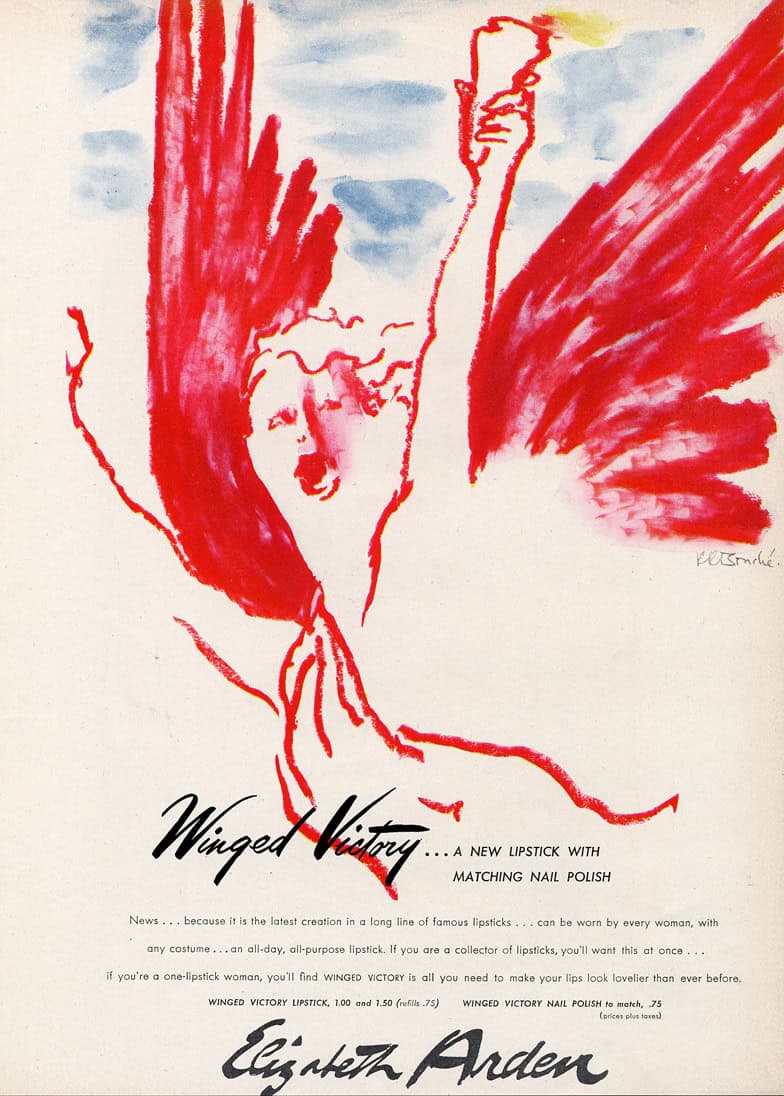
The victories of World War II in Europe finally arrive in May of 1945. Surrender and liberation were widely celebrated in the streets and in patriotic organized events recognizing duty and sacrifice. The fashion image was also part of the celebration.
René Bouché
Illustration artist, René Bouché was quickly gaining recognition as a fashion illustrator throughout World War II. In particular, engaging in longstanding commercial illustration contracts with Vogue, Saks Fifth Avenue and at Elizabeth Arden as a chief advertising campaign illustrator .
Abstract Expressionism
During the mid and late nineteen forties he was teaching at Parsons School of Design and the Art Student’s League in New York. The art scene in New York during the nineteen forties had become an epicenter of new ideas. The art being made in the city played a significant role in laying the foundations for the new movement. First called the New York School later widely recognized as Abstract Expressionism. It was the art movement that would define what modern art is at the beginning of the Cold War. During the nineteen forties to the early nineteen fifties Bouché became absorbed in Abstract Expressionism. Having long close friendships with painters such as Robert Motherwell , Willem de Kooning and other artist associated with The Eighth Street Avant-Garde Painters Club.
Winged Victory
Bouché’s figurative fashion and society portrait style is recognizable in terms of; blotted and bleeding line qualities along with strict color composition. There was always the successful fashion illustration focus, on the news of the fashion or object. In the case of his society portraits he emphasized memorable and striking details about the sitter. In particular the 1945 Elizabeth Arden Winged Victory lipstick advertisement shows the impact of his artistic circle.
Hence in this instance his commercial vocabulary embraces an expressive gesture looking to a recognizable symbol of victory in Europe and freedom in America. The figure heralds the ‘News…’ proclaimed within the copy. Furthermore, the beauty with civic narrative was about being resilient, the Arden business message of staying focused on a grater objective and the arching cultural understanding that responsibility in the face of danger yields positive results for all …The new red lipstick “can be worn by every woman with every costume.”
Patrick Michael Hughes Senior Fashion Editor
Share this post
Patrick Michael Hughes is a fashion and decorative arts historian. He writes about fashion culture past and present making connections to New York, London and Copenhagen's fashion weeks with an eye toward men's fashion. He joined IRK Magazine as a fashion men's editor during winter of 2017.
He is often cited as a historical source for numerous pieces appearing in the Wall Street Journal, The New York Times, CNN, LVMH, Conde Nast, Highsnobiety and others. His fashion career includes years as a fashion reporter/producer of branded content for the New York local news in the hyper digital sector. Patrick's love of travel and terrain enabled him to becoming an experienced cross-country equestrian intensively riding in a number of locations in South America Scandinavia,The United Kingdom and Germany. However, he is not currently riding, but rather speaking internationally to designers, product development teams, marketing teams and ascending designers in the US, Europe and China.
Following his BA in the History of Art from Manhattanville College in Purchase, New York he later completed graduate studios in exhibition design in New York. it was with the nudge and a conversation in regard to a design assignment interviewing Richard Martin curator of the Costume Institute at the Metropolitan Museum of Art he was encouraged to consider shifting his focus to the decorative arts with a concentration in fashion history and curation.
Patrick completed graduate studies 17th and 18th century French Royal interiors and decoration and 18th century French fashion culture at Musée Les Arts Decoratifs-Musée de Louvre in Paris. Upon his return to New York along with other classes and independent studies in American fashion he earned his MA in the History of Decorative Arts and Design from the Parsons/Cooper Hewitt Design Museum program in New York. His final specialist focus was in 19th century English fashion and interiors with distinction in 20th century American fashion history and design.
Currently, he is an Associate Teaching Professor at Parsons School of Design leading fashion history lecture-studios within the School of Art and Design History and Theory,
Read Next

